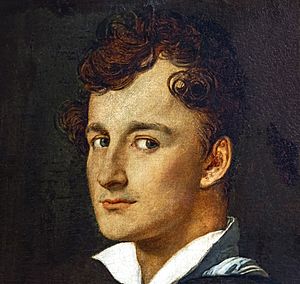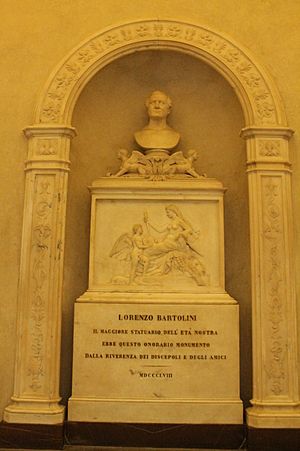Lorenzo Bartolini facts for kids

Lorenzo Bartolini (born in Prato, 7 January 1777 – died in Florence, 20 January 1850) was a famous Italian sculptor. He mixed the classical style called neoclassicism with feelings and realistic details. He found inspiration in the art of the Florentine Renaissance. This made his work different from many other artists of his time who were heavily influenced by Antonio Canova.
Contents
The Life of Lorenzo Bartolini
Early Life and Training
Lorenzo Bartolini was born in Savignano di Prato, a small place near Prato in Tuscany. He started his art journey by studying at the Florentine Academy of Fine Arts. There, he became very skilled at making models, especially with alabaster stone.
In 1797, he moved to Paris. He first studied painting with Jean-Baptiste Frédéric Desmarais. Later, he switched to sculpture and learned from François-Frédéric Lemot.
Rising to Fame
In 1803, Bartolini created a sculpture called Cleobis and Biton. It was a bas-relief, which is a type of sculpture where the figures stick out slightly from a flat background. This work won him second prize at the Academy. It quickly made him famous and helped him gain important supporters.
He also created a bas-relief showing the Battle of Austerlitz. This piece was made for a tall column in Place Vendôme in Paris. He also made smaller artworks for Vivant Denon and busts (sculptures of heads and shoulders) of famous music composers like Méhul and Cherubini.
Working for Napoleon
Bartolini's most important supporter was Napoleon Bonaparte. He made a huge bust of Napoleon. In 1807, Napoleon sent Bartolini to the Accademia Carrara in Bergamo. He was sent there to teach sculpture, even though some local people didn't want him.
Bartolini stayed in Bergamo as the official portrait sculptor for Napoleon's family until Napoleon's power ended. In 1833, Bartolini was recognized for his talent and became an honorary member of the National Academy of Design. After Napoleon's fall, Bartolini moved to Florence, where he lived until he passed away.
He was buried in the Church of Santa Croce in Florence, a very famous church.
Famous Sculptures and Artworks
When Bartolini moved to Florence, his connections to Napoleon and his unique artistic style made things a bit difficult for him. His style was different from the strict classical rules taught at the Academy.
Naturalistic Style
Bartolini's natural and somewhat emotional marble sculpture called L'Ammostatore ("The Bird's-nest Stealer", 1820) was inspired by older Florentine sculptors from the 1400s, like Andrea del Verrocchio. These artists were not always fully appreciated at the time.
During a period when he didn't have much money, he received support from people outside Italy. For example, he created the funeral monument for Princess Sofia Zamoyski Czartoriski (who died in 1837). This monument, located in Santa Croce in Florence, showed his naturalistic style.
Important Commissions
Bartolini also created two other monuments in Santa Croce. One is for Carlotta Buonaparte (who died in 1839). However, when a project needed a more formal look, like the monument for Leone Battista Alberti, the result could be less warm.
In 1830, he received a very important job from the sons of a Russian prince named Nicola Demidoff. The sons asked him to create the Monument to Nicola Demidoff to honor their father. This large monument, which has many figures, was worked on during Bartolini's last years. His assistant, Pasquale Romanelli, finished it after Bartolini's death.
Bartolini made many different types of artworks, including a huge number of portrait busts. Some of his best works include the group sculpture called Charity (1824), Hercules and Lichas, and Faith in God. He also created a portrait statue of Machiavelli. This was his only work chosen to be placed in the empty outdoor niches of the Uffizi gallery, alongside statues of other famous Florentine men.
Honors and Recognition
- 1847: Lorenzo Bartolini became a member of the Royal Academy of Science, Letters and Fine Arts of Belgium.
Images for kids
See also
 In Spanish: Lorenzo Bartolini para niños
In Spanish: Lorenzo Bartolini para niños



